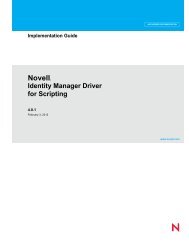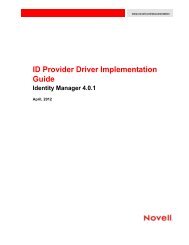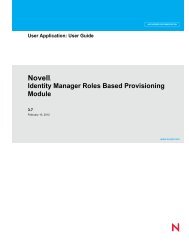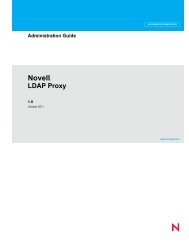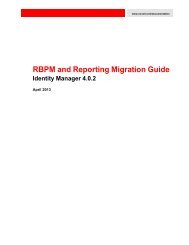Novell eDirectory 8.8 Installation Guide - NetIQ
Novell eDirectory 8.8 Installation Guide - NetIQ
Novell eDirectory 8.8 Installation Guide - NetIQ
Create successful ePaper yourself
Turn your PDF publications into a flip-book with our unique Google optimized e-Paper software.
2.7.7 Unattended Install and Upgrade to <strong>eDirectory</strong> <strong>8.8</strong> SP3 on<br />
Windows<br />
Prerequisites<br />
• Ensure Microsoft Visual C++ 2005 Runtime Libraries are installed. Install them manually from<br />
vcredist_x86.exe, located at <strong>eDirectory</strong>\nt\i386\redist_pkg.<br />
novdocx (en) 11 July 2008<br />
<strong>eDirectory</strong> <strong>8.8</strong> SP3 automates the <strong>eDirectory</strong> installation and upgrade so that <strong>eDirectory</strong> is installed<br />
or upgraded silently on Windows servers without human intervention.<br />
On Windows, the unattended installation of <strong>eDirectory</strong> uses predefined text files that facilitate the<br />
unattended installation.The following sections discuss various features that can be used to configure<br />
the unattended installation, including the install location, no display of splash screens, port<br />
configurations, additional NMAS methods, stopping and starting SNMP services, etc.<br />
• “Response Files” on page 34<br />
• “Adding Features to the Automated <strong>Installation</strong>” on page 35<br />
• “Controlling Automated <strong>Installation</strong>” on page 40<br />
• “Unattended <strong>Installation</strong> of <strong>eDirectory</strong> using Response File” on page 43<br />
Response Files<br />
Installing or upgrading to <strong>eDirectory</strong> <strong>8.8</strong> SP3 on Windows operating system can be made silent and<br />
more flexible by using a response file for the following:<br />
• Complete unattended installation with all required user inputs<br />
• Default configuration of components<br />
• Bypassing all prompts during the installation<br />
A response file is a text file containing sections and keys, similar to a Windows.ini file. You can<br />
create and edit a response file using any ASCII text editor. The <strong>eDirectory</strong> upgrade reads the<br />
installation parameters directly from the response file and replaces the default installation values<br />
with response file values. The installation program accepts the values from the response file and<br />
continues to install without prompts.<br />
Response.ni File Sections and Keys<br />
The <strong>eDirectory</strong> <strong>8.8</strong> SP3 installation requires changes to the sections in the response file to add<br />
information about the <strong>eDirectory</strong> instance to be installed, including the tree name, administrator<br />
context, administrator credentials (including user name and passwords), installation locations, etc. A<br />
full list of the keys and their default values is available in the sample response.ni file that is<br />
delivered with the <strong>eDirectory</strong> installation.<br />
NOTE: You should use the provided response.ni file available at<br />
<strong>eDirectory</strong>\nt\i386\NDSonNT\response.ni in the <strong>eDirectory</strong> installation.There are<br />
essential parameters and set by default in this file. When editing the response.ni file, ensure<br />
there are no blank spaces between the key and the values along with the equals sign ("=") in each<br />
key-value pair.<br />
34 <strong>Novell</strong> <strong>eDirectory</strong> <strong>8.8</strong> <strong>Installation</strong> <strong>Guide</strong>




